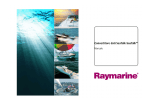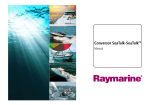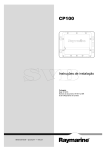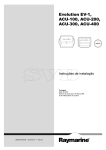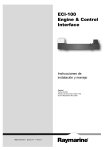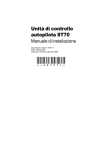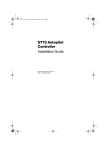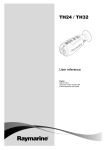Download Raymarine SeaTalk-SeaTalk ng Installation manual
Transcript
SeaTalk-SeaTalkng converter Handbook Trademarks and registered trademarks Autohelm, hsb2, RayTech Navigator, Sail Pilot, SeaTalk, SeaTalkNG, SeaTalkHS and Sportpilot are registered trademarks of Raymarine UK Limited. RayTalk, Seahawk, Smartpilot, Pathfinder and Raymarine are registered trademarks of Raymarine Holdings Limited. All other product names are trademarks or registered trademarks of their respective owners. Fair Use Statement You may print no more than three copies of this manual for your own use. You may not make any further copies or distribute or use the manual in any other way including without limitation exploiting the manual commercially or giving or selling copies to third parties. Copyright ©2010 Raymarine UK Ltd. All rights reserved. ENGLISH Document number: 87121-3 Date: 06-2010 Chapter 1: Introduction • Heading • Navigation Data (Waypoint information) • Rudder angle SeaTalk - SeaTalkng converter The SeaTalk - SeaTalkng converter allows connection of a range of SeaTalk compatible products to the SeaTalkng network. It contains electronics to bridge communications between the 2, allowing information to be shared. Handbook information This handbook describes how to include the SeaTalk to SeaTalkng converter within the system of Raymarine electronics on your boat. It includes information to help you: • understand which Raymarine equipment is compatible with the converter, • install and connect the converter within your system. Additional handbooks You may also need the additional information included in the SeaTalkng reference manual. In particular for assistance with: • constructing the SeaTalkng network and backbone, • connecting power, and • LEN loading calculations. D11804-1 Data types supported Description Part number SeaTalkng reference manual 81300 All documents are available to download as PDFs from www.raymarine.com. The converter supports the following types of data: • Instrument and environment (Depth, Speed, Wind etc.) • MOB (Man Overboard) • GPS Introduction 5 Important information Warning: Potential ignition source This product is NOT approved for use in hazardous/flammable atmospheres. Do NOT install in a hazardous/flammable atmosphere (such as in an engine room or near fuel tanks). Caution: Power supply protection When installing this product ensure the power source is adequately protected by means of a suitably-rated fuse or automatic circuit breaker. Warning: Product installation and operation This product must be installed and operated in accordance with the instructions provided. Failure to do so could result in personal injury, damage to your boat and/or poor product performance. Caution: Service and maintenance This product contains no user serviceable components. Please refer all maintenance and repair to authorized Raymarine dealers. Unauthorized repair may affect your warranty. Warning: Switch off power supply Ensure the boat’s power supply is switched OFF before starting to install this product. Do NOT connect or disconnect equipment with the power switched on, unless instructed in this document. 6 Declaration of conformity Raymarine Ltd. declares that the SeaTalk to SeaTalkng converter is in compliance with the essential requirements of EMC directive 2004/108/EC. The original Declaration of Conformity certificate may be viewed on the relevant product page at www.raymarine.com EMC installation guidelines Raymarine equipment and accessories conform to the appropriate Electromagnetic Compatibility (EMC) regulations, to minimize electromagnetic interference between equipment and minimize the effect such interference could have on the performance of your system Correct installation is required to ensure that EMC performance is not compromised. For optimum EMC performance we recommend that wherever possible: • Raymarine equipment and cables connected to it are: – At least 1 m (3 ft) from any equipment transmitting or cables carrying radio signals e.g. VHF radios, cables and antennas. In the case of SSB radios, the distance should be increased to 7 ft (2 m). – More than 2 m (7 ft) from the path of a radar beam. A radar beam can normally be assumed to spread 20 degrees above and below the radiating element. • The product is supplied from a separate battery from that used for engine start. This is important to prevent erratic behavior and data loss which can occur if the engine start does not have a separate battery. • Raymarine specified cables are used. • Cables are not cut or extended, unless doing so is detailed in the installation manual. SeaTalk - SeaTalk ng converter Note: Where constraints on the installation prevent any of the above recommendations, always ensure the maximum possible separation between different items of electrical equipment, to provide the best conditions for EMC performance throughout the installation Product disposal Dispose of this product in accordance with the WEEE Directive. Water ingress Water ingress disclaimer Although the waterproof rating capacity of Raymarine products exceeds that called for by the IPX6 standard, water intrusion and subsequent equipment failure may occur if any Raymarine equipment is subjected to commercial high pressure washing. Raymarine will not warrant equipment subjected to high pressure washing. The Waste Electrical and Electronic Equipment (WEEE) Directive requires the recycling of waste electrical and electronic equipment. Whilst the WEEE Directive does not apply to some Raymarine products, we support its policy and ask you to be aware of how to dispose of this product. Technical accuracy To the best of our knowledge, the information in this document was correct at the time it was produced. However, Raymarine cannot accept liability for any inaccuracies or omissions it may contain. In addition, our policy of continuous product improvement may change specifications without notice. As a result, Raymarine cannot accept liability for any differences between the product and this document. Warranty registration To register your Raymarine product ownership, please take a few minutes to fill out the warranty registration card found in the box, or visit www.raymarine.com and register on-line. It is important that you register your product to receive full warranty benefits. Your unit package includes a bar code label indicating the serial number of the unit. You should stick this label to the warranty registration card. Introduction 7 8 SeaTalk - SeaTalk ng converter Chapter 2: Parts and accessories Chapter contents • 2.1 Parts supplied on page 10 • 2.2 SeaTalk - SeaTalkng converter cables on page 11 Parts and accessories 9 2.1 Parts supplied Note: Fit the blanking plugs supplied into any unused SeaTalkng connection. The following items are included with the SeaTalk - SeaTalkng converter kit. 1 4 2 3 5 6 D11805-3 1 SeaTalk - SeaTalkng converter 2 SeaTalkng terminator (x2) 3 SeaTalk ng blanking plugs (x2) 4 400 mm (15 in) SeaTalk - SeaTalkng converter cable. This cable connects the converter to the first SeaTalk device on the spur. 5 SeaTalkng power cable 6 1 m (3.3 ft) SeaTalkng spur cable 10 SeaTalk - SeaTalk ng converter 2.2 SeaTalk - SeaTalkng converter cables These cables are available as accessories. They are also included with some compatible products. 1 2 D11824-1 Description Part No. 1 1 m (3.3 ft) SeaTalk - SeaTalkng converter cable. This cable connects the converter to the first SeaTalk device on the spur. A22164 2 10 m (32.8 ft) RS125 - Converter cable. This is required when connecting the converter to an RS125 GPS. R32120 Parts and accessories 11 12 SeaTalk - SeaTalk ng converter Chapter 3: Installation Chapter contents • 3.1 Typical systems on page 14 • 3.2 SeaTalk - SeaTalkng converter connections on page 18 • 3.3 Making SeaTalkng connections on page 22 • 3.4 System checks on page 23 Installation 13 3.1 Typical systems Example: SeaTalkng system with SeaTalk instruments 1 2 CANCEL ENTER 3 CANCEL MENU ENTER MENU SeaTalk SeaTalkng 7 SeaTalkng SeaTalkng SeaTalkhs 4 SeaTalkng 5 6 12 / 24 V SMARTPILOT D11806-1 14 SeaTalk - SeaTalk ng converter 1 Multifunction display with integrated GPS (e.g. C-Series Widescreen) 2 SeaTalkng autopilot controller and master instrument (e.g. ST70) 3 SeaTalk repeat instruments (e.g ST60+) 4 SeaTalk - SeaTalkng converter 5 SeaTalkng autopilot course computer 6 Transducers connected via SeaTalkng 7 SeaTalkhs connection (e.g. for digital radar) Installation 15 Example: SeaTalk system with SeaTalkng multifunction display 1 2 3 4 SeaTalk SeaTalkng 12 V SeaTalk SeaTalk SeaTalkhs SeaTalkhs 7 SeaTalk / NMEA0183 SeaTalkng 6 5 SeaTalkhs D11812-1 1 Multifunction display 2 SeaTalk autopilot system (This cannot be connected to the converter.) 16 SeaTalk - SeaTalk ng converter 3 SeaTalk spur containing instruments and MOB system 4 SeaTalk spur containing RS125 GPS 5&6 SeaTalk - SeaTalkng converter 7 SeaTalkhs network (e.g. for digital sounder and radar) Autopilot restrictions Important: A SeaTalk autopilot or associated controller must not be connected to the SeaTalk - SeaTalkng converter. SeaTalkng is a proprietary extension to NMEA 2000 and the proven CAN bus technology. Compatible NMEA 2000 and SeaTalk / SeaTalk2 devices can also be connected using the appropriate interfaces or adaptor cables as required. There are restrictions as to how an autopilot is connected in a system containing a SeaTalk - SeaTalkng converter. • SeaTalkng autopilot (e.g. SPX course computer with ST70 controller) — This can be connected as part of the SeaTalkng system in the usual manner. However any SeaTalk cable from the autopilot must NOT be connected to the converter. • SeaTalk autopilot (e.g. S1, S2 or S3 course computer with ST6002 controller) — This cannot be connected to the converter, nor to any device on the converter’s SeaTalk spur. A SeaTalk autopilot will usually be connected directly to the multifunction display. Seatalkng SeaTalkng (Next Generation) is an enhanced protocol for connection of compatible marine instruments and equipment. It replaces the older SeaTalk and SeaTalk2 protocols. SeaTalkng utilizes a single backbone to which compatible instruments connect using a spur. Data and power are carried within the backbone. Devices that have a low draw can be powered from the network, although high current equipment will need to have a separate power connection. Installation 17 3.2 SeaTalk - SeaTalkng converter connections • It cannot be linked to other parts of the SeaTalk system (it is an isolated spur). The converter connects in line as part of the SeaTalkng backbone. It provides connections for SeaTalkng and SeaTalk devices. • It must not be connected to any power supply. SeaTalkng spur connections These allow connection of a standard SeaTalkng spur, and form part of the SeaTalkng bus. Avoid data and ground loops Important: The converter must only be connected to either the SeaTalk or SeaTalkng connections of any device, NOT both. Converter power supply The converter takes its power from the SeaTalkng bus and provides power to devices on the SeaTalk spur. 1 2 3 4 5 D11807-1 1 Blue — SeaTalkng backbone connection 2 White — SeaTalkng spur connection 3 Yellow — SeaTalk spur connection 4 White — SeaTalkng spur connection 5 Blue — SeaTalkng backbone connection Power must not be connected into the SeaTalk spur. To be certain, disconnect any existing separate power connection at the SeaTalk devices on the spur. SeaTalk spur connection The converter will support connection of a single isolated SeaTalk spur. The converter bridges data between this SeaTalk spur and the SeaTalkng bus. Please note the following regarding the SeaTalk spur: • The spur is for connection of up to 5 SeaTalk devices. 18 SeaTalk - SeaTalk ng converter SeaTalk instrument connection to the SeaTalkng converter Note: The instruments are powered from the connection to the converter. Any existing separate power connection to the instruments must be completely disconnected. 1 LifeTag connection to the SeaTalk - SeaTalkng converter The LifeTag Base Station can be connected as part of the isolated spur into the converter. 2 Note: The LifeTag Base Station is powered from its connection to the converter. Any existing separate power connection to the Base Station must be completely disconnected. 3 4 Direct connection You can connect the LifeTag Man Overboard (MOB) system directly to the converter using the SeaTalk - SeaTalkng converter cable. 12V 5 D11808-1 1 ST60+ or ST40 instruments connected on a SeaTalk spur. The spur may contain a maximum of 5 SeaTalk instruments. 2 SeaTalk - SeaTalkng converter cable. 3 SeaTalk cable. 4 Transducers connected directly to instrument. 5 Appropriate rated, fused and switched power supply into SeaTalkng backbone. (This may be a dedicated spur, or from an appropriate power source such as an autopilot course computer.) Installation 19 Connection via a SeaTalk block The LifeTag Base Station and converter can be connected using a SeaTalk block. This may be useful in an existing installation where the Base Station already has the SeaTalk cable attached. 1 1 1 2 3 2 2 3 6 3 4 D11822-1 5 4 1 LifeTag Base Station 2 SeaTalk - SeaTalk ng converter cable 1 LifeTag Base Station 3 SeaTalkng backbone 2 SeaTalk cable (bare ends into Base Station) 4 SeaTalk - SeaTalkng converter 3 SeaTalk block 4 SeaTalkng backbone Connection colors D11810-1 1 Red (12 V) 5 SeaTalk to SeaTalkng converter 2 Screen 6 SeaTalk - SeaTalk ng converter cable 3 Yellow (SeaTalk data) Connection into a compatible device The MOB can be connected into a compatible device on the SeaTalk spur. 20 SeaTalk - SeaTalk ng converter 1 2 1 3 6 2 5 4 D11821-1 1 Compatible SeaTalk device (e.g. an ST60+ instrument) 2 LifeTag Base Station 3 SeaTalk cable 4 SeaTalkng 5 SeaTalk to SeaTalkng converter 6 SeaTalk - SeaTalkng converter cable 3 backbone RS125 GPS connection to SeaTalk converter SeaTalkng 4 D11809-2 1 RS125 GPS 2 RS125 to converter cable — The GPS must be the only device on this spur. 3 SeaTalkng backbone 4 SeaTalk - SeaTalkng converter Important: The GPS connects directly to the SeaTalk connection on the converter. It cannot share this connection with other devices. Installation 21 3.3 Making SeaTalkng connections Cable types and length 1. Rotate collar to UNLOCKED position (so molded arrows are aligned). 2. Ensure cable end connector is correctly oriented, then fully insert. It is important to use cables of the appropriate type and length • Unless otherwise stated use only standard cables of the correct type, supplied by Raymarine. • Ensure that any non-Raymarine cables are of the correct quality and gauge. For example, longer power cable runs may require larger wire gauges to minimize voltage drop along the run. Routing cables Cables must be routed correctly, to maximize performance and prolong cable life. • Do NOT bend cables excessively. Wherever possible, ensure a minimum bend radius of 100 mm. D11827-1 3. Rotate collar (2 clicks) until it snaps into the LOCKED position (almost one quarter turn). Minimum bend 200 mm (8 in) diameter Minimum bend of cable 100 mm (4 in) radius • Protect all cables from physical damage and exposure to heat. Use trunking or conduit where possible. Do NOT run cables through bilges or doorways, or close to moving or hot objects. • Secure cables in place using tie-wraps or lacing twine. Coil any extra cable and tie it out of the way. • Where a cable passes through an exposed bulkhead or deckhead, use a suitable watertight feed-through. • Do NOT run cables near to engines or fluorescent lights. D11828-1 22 Always route data cables as far away as possible from: SeaTalk - SeaTalk ng converter • other equipment and cables, • high current carrying ac and dc power lines, • antennae. 3.4 System checks After connection of the SeaTalk - SeaTalkng converter it is advisable to perform checks on the data shared around the system. Typical checks should include: Strain relief Ensure adequate strain relief is provided. Protect connectors from strain and ensure they will not pull out under extreme sea conditions. Cable shielding Ensure that all data cables are properly shielded that the cable shielding is intact (e.g. hasn’t been scraped off by being squeezed through a tight area). • Check your GPS position. At a known location check that the GPS position is accurately shown on all displays and appropriate instruments. • Calibrate wind, speed, depth etc. Ensure that instrument data is accurate and is available at all appropriate displays and instruments. • LifeTag MOB functional test. Check that the LifeTag system generates the appropriate warnings / alarms at all appropriate displays and instruments. • Autopilot test. Check that the autopilot operates as expected and that heading information is available at all appropriate displays and instruments. All checks should be performed in a safe and familiar environment and in accordance with the instructions supplied with each product. Installation 23 24 SeaTalk - SeaTalk ng converter Chapter 4: Troubleshooting and support Chapter contents • 4.1 System data troubleshooting on page 26 • 4.2 SeaTalk - SeaTalkng converter LED indications on page 27 • 4.3 Raymarine technical support on page 27 Troubleshooting and support 25 4.1 System data troubleshooting Aspects of the installation can cause problems with the data shared between connected equipment. Such problems, their possible causes and solutions are described here. Problem Possible causes Possible solutions Instrument, engine or other system data is unavailable at all displays. Data is not being received at the display. Check the data bus (e.g. SeaTalkng) wiring and connections. Check the overall integrity of the data bus (e.g. SeaTalkng) wiring. If available refer to the reference guide for the data bus. (e.g. SeaTalkng reference manual) Data source (e.g ST70 instrument or engine interface) is not operating. Check the source of the missing data (e.g. ST70 instrument or engine interface). Check the power to the SeaTalk bus. Refer to the manufacturer’s handbook for the equipment in question. Instrument or other system data is missing from some but not all displays. Software mismatch between equipment may prevent communication. Contact Raymarine technical support. SeaTalkhs network problem Check that all required equipment is connected to the SeaTalkhs switch. Check the status of the SeaTalkhs Switch. Check that SeaTalkhs cables are free from damage. Software mismatch between equipment may prevent communication. 26 Contact Raymarine technical support SeaTalk - SeaTalk ng converter 4.2 SeaTalk - SeaTalkng converter LED indications The LED indicates SeaTalkng and SeaTalk connection status. LED state (8 Second cycle) SeaTalkng connection status SeaTalk connection status Healthy Healthy 4.3 Raymarine technical support Raymarine provides a comprehensive customer support service, on the world wide web, through our worldwide dealer network and by telephone help line. If you are unable to resolve a problem, please use any of these facilities to obtain additional help. Web support Please visit the customer support area of our website at: www.raymarine.com Not connected / fault Not connected / fault This contains Frequently Asked Questions, servicing information, e-mail access to the Raymarine Technical Support Department and details of worldwide Raymarine agents. Telephone support Not connected / fault Healthy Healthy Not connected / fault Connected but not receiving data Not connected / fault High voltage (power supply too high) In the USA call: +1 603 881 5200 extension 2444 In the UK, Europe, the Middle East, or Far East call: +44 (0)23 9271 4713 Product information If you need to request service, please have the following information to hand: • Product name. • Product identity. • Serial number. • Software application version. Low voltage / Converter not operational Troubleshooting and support You can obtain this product information using the menus within your product. 27 28 SeaTalk - SeaTalk ng converter Appendix A Compatible SeaTalk devices Appendix B Technical specification The following SeaTalk instruments and equipment can be connected to the converter Description ST40 Bidata Nominal supply voltage 12 V dc Operating voltage range 9 to 16 V dc Current • 50 mA converter peak operating current ST40 Depth • 950 mA total peak supply to SeaTalk / SeaTalkng devices on spur connections. ST40 Speed ST40 Wind ST40 Compass ST60+ Tridata LEN (Refer to Seatalkng reference manual for further information. LEN 1, plus 3 for each SeaTalk instrument taking power from the converter. Environmental Installation environment ST60+ Depth • Operating temperature: -10 ºC to +50 ºC (14 ºF to 122 ºF) ST60+ Speed ST60+ Wind • Storage temperature: -20 ºC to +65 ºC (-4 ºF to 149 ºF) ST60+ Compass / Heading • Relative humidity: max 95% ST60+ Rudder angle • Water proof to IPX6 ST60+ Repeaters RS125 and RS125 PLUS GPS sensors Data connections. • SeaTalkng backbone • 2 x SeaTalk ng spur LifeTag Wireless MOB system • 1 x SeaTalk spur Conformance • Europe: 2004/108/EC • Australia and New Zealand: C-Tick, Compliance Level 2 Compatible SeaTalk devices 29 Dimensions W 110 mm (4.3 in) x Max. D 22 mm (0.9 in) x H 22 mm (0.9 in) 30 SeaTalk - SeaTalk ng converter www.raymarine.com
































